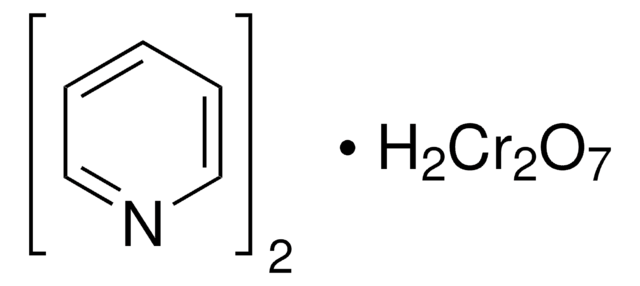About This Item
Recommended Products
Assay
98%
form
solid
reaction suitability
reagent type: oxidant
mp
205-208 °C (lit.)
SMILES string
O[Cr](Cl)(=O)=O.c1ccncc1
InChI
1S/C5H5N.ClH.Cr.H2O.2O/c1-2-4-6-5-3-1;;;;;/h1-5H;1H;;1H2;;/q;;+2;;;/p-2
InChI key
JWIPGAFCGUDKEY-UHFFFAOYSA-L
Looking for similar products? Visit Product Comparison Guide
General description
Application
Signal Word
Danger
Hazard Statements
Precautionary Statements
Hazard Classifications
Aquatic Acute 1 - Aquatic Chronic 1 - Carc. 1B Inhalation - Ox. Sol. 2 - Skin Sens. 1
Storage Class Code
5.1B - Oxidizing hazardous materials
WGK
WGK 2
Flash Point(F)
Not applicable
Flash Point(C)
Not applicable
Personal Protective Equipment
Certificates of Analysis (COA)
Search for Certificates of Analysis (COA) by entering the products Lot/Batch Number. Lot and Batch Numbers can be found on a product’s label following the words ‘Lot’ or ‘Batch’.
Already Own This Product?
Find documentation for the products that you have recently purchased in the Document Library.
Customers Also Viewed
Articles
Oxidation and reduction reactions are some of the most common transformations encountered in organic synthesis, and are some of the organic chemist’s most powerful tools for creating novel products. Below is a list of the most commonly used oxidizing and reducing agents currently available in our catalog.
Our team of scientists has experience in all areas of research including Life Science, Material Science, Chemical Synthesis, Chromatography, Analytical and many others.
Contact Technical Service













